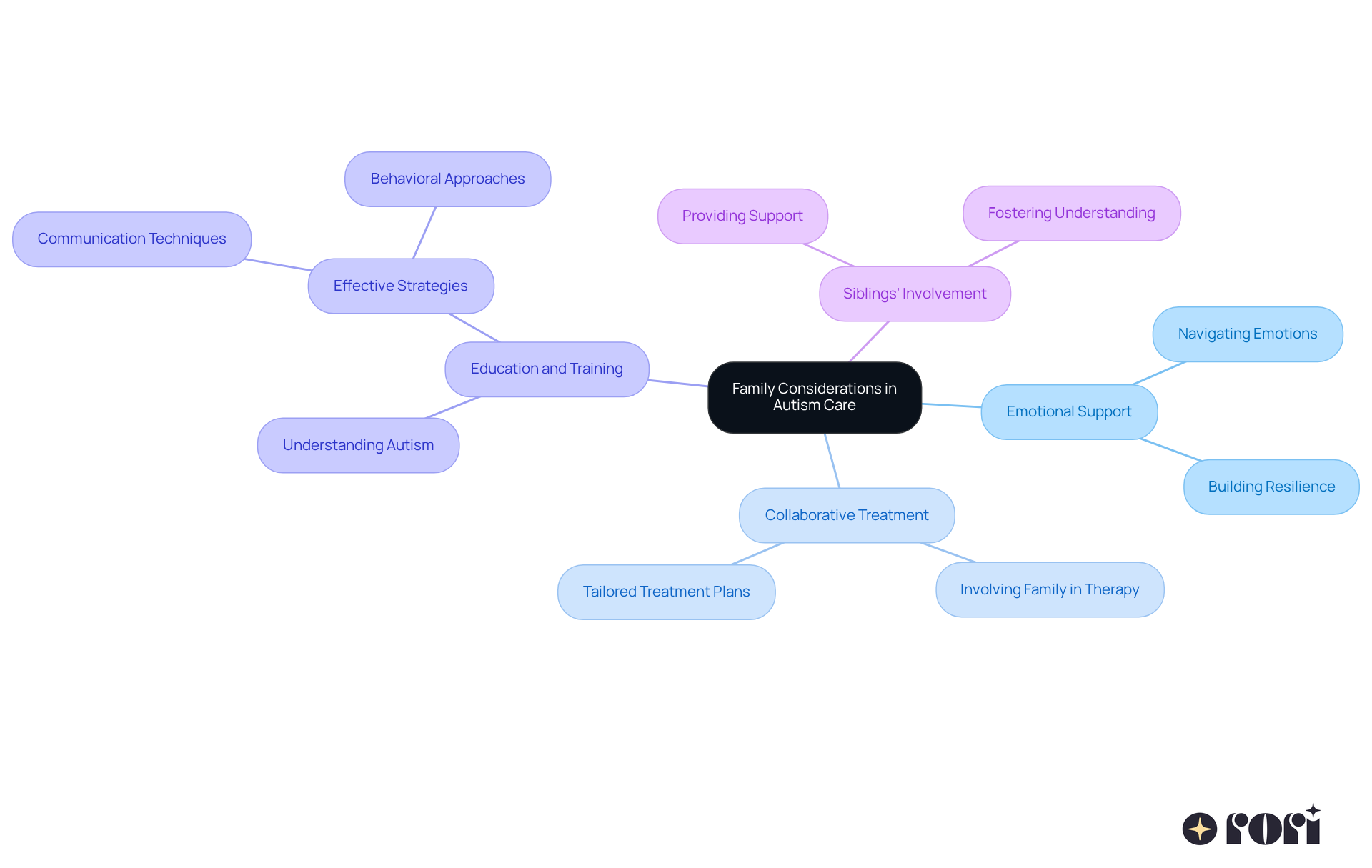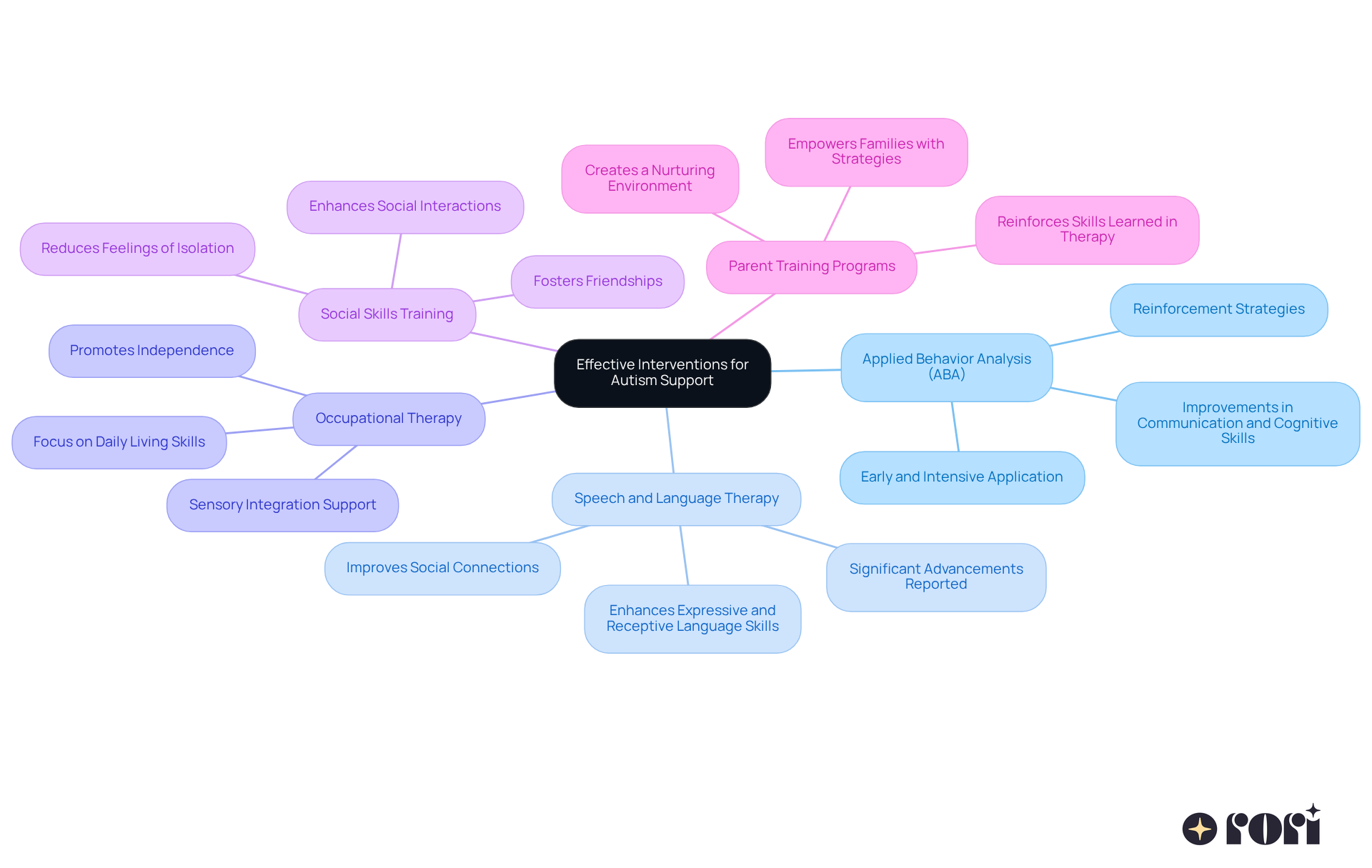Navigating the complexities of an autism diagnosis in young children can feel overwhelming for families. It’s important to understand the spectrum of Autism Spectrum Disorder (ASD), as early identification and intervention can truly make a difference in a child's developmental journey. Many parents, however, find it tough to recognize the signs and access the right support systems.
So, how can caregivers effectively navigate this intricate process? 🤔 It’s all about ensuring your child receives the best possible care and resources. Let’s explore this together! We’re here to help you every step of the way!
Autism Spectrum Disorder (ASD) includes a wide range of symptoms that can look different for each child. Let’s take a closer look at some of the key characteristics:
Spotting these signs early can lead to timely evaluations and support, which are crucial for effective intervention strategies following an autism diagnosis in young children. Educating caregivers is key here! It helps them gain the knowledge and skills needed to support their child’s goals. By understanding ABA principles and strategies, caregivers can make informed choices that positively impact their child’s journey. This education not only boosts their confidence but also complements professional help, creating a consistent and nurturing environment for the little one.
As specialists often say, early identification can significantly improve outcomes for individuals following an autism diagnosis in young children, helping them thrive in social settings and learn essential life skills. Plus, it’s interesting to note that prevalence rates of ASD can vary among different racial and ethnic groups, which has important implications for understanding and addressing the needs of affected youth. Real-life examples, like the positive outcomes seen in children who receive early support, really highlight the importance of recognizing these signs promptly.
Let’s explore this together! If you have any thoughts or experiences to share, we’d love to hear from you!

Identifying the right condition early on, including an autism diagnosis in young children, is so important for getting the help kids and their families need. It’s all about providing timely support and resources. There are several screening methods that play a key role in spotting autism, and here’s a friendly rundown of them:
Developmental Screening: Usually done during regular pediatric visits, these screenings check on developmental milestones and can help flag kids who might be at risk for autism. The American Academy of Pediatrics suggests screening at 18 and 24 months, making sure any developmental concerns are addressed quickly.
Parent Questionnaires: Tools like the Modified Checklist for Autism in Toddlers, Revised with Follow-Up (M-CHAT-R/F) let parents share their observations about their child’s behavior and development. These questionnaires are super helpful for gathering initial insights that can guide further evaluation related to autism diagnosis in young children.
Observational Assessments: Healthcare professionals might conduct observational assessments, watching how a child interacts and behaves in different settings. This method provides valuable insights into social and communication skills, which are crucial for facilitating an autism diagnosis in young children.
Recent studies highlight how effective these developmental screening methods can be in catching an autism diagnosis in young children early. For instance, a multistage screening protocol used in early support settings resulted in a 60% increase in ASD diagnoses, particularly benefiting Spanish-speaking families. This really shows how important it is to have comprehensive screening approaches that involve both clinicians and parents.
Parents, don’t hesitate to bring up any concerns with your pediatrician! Recognizing issues early not only helps you access essential support but also improves long-term developmental outcomes for your little ones with developmental disorders. Let’s explore this together!

Navigating the diagnostic assessment for autism diagnosis in young children can feel overwhelming, but understanding the process can truly empower you as a parent. It’s all about advocating for your child and ensuring they get the evaluations they need. Plus, caregiver education is key! It arms you with the knowledge and skills to provide better support at home, working hand-in-hand with professional interventions to create a consistent environment for your little one.
By understanding the diagnostic evaluation process and engaging in caregiver education, you can create a nurturing atmosphere that fosters your child’s development and well-being. This education not only eases your stress but also enhances the overall dynamics at home, making it a more supportive space for your child. Let’s explore this journey together!

Family considerations play a huge role in the autism diagnosis and care process, shaping outcomes and emotional well-being. When an autism diagnosis in young children is received, individuals often find themselves navigating a whirlwind of emotions, ranging from confusion to relief. It’s so important to provide strong emotional support and resources to help them cope and build resilience.
Involving family members in therapy sessions and treatment planning creates a collaborative approach that really boosts the support system for the young individual. This teamwork not only strengthens family bonds but also ensures that treatment plans are tailored to meet the unique needs of the child. Research shows that when relatives actively participate, it can lead to better treatment outcomes, enhancing the learning environment both at home and in therapy.
Education and training for families are key. Understanding autism and effective strategies - like communication techniques and behavioral approaches - empowers families to support their child's growth more effectively. Resources that offer insights into autism can equip families with the knowledge they need to tackle challenges and celebrate progress together.
Let’s not forget about siblings! They might feel overlooked or confused by the changes in family dynamics after a diagnosis. Providing them with support and information can help them understand their role and foster a sense of belonging within the family.
By considering these aspects, families can create a nurturing environment that supports the young one's growth and development. This ultimately leads to a more positive experience for everyone involved. Let’s explore this journey together!

Supporting children with autism can feel like a journey, and there are some effective interventions that can really make a difference. Let’s explore this together!
Applied Behavior Analysis (ABA): This approach is all about using reinforcement strategies to encourage positive behaviors while reducing challenging ones. Research shows that when ABA is applied early and intensively-especially before the age of 2-it can lead to amazing improvements in communication, cognitive skills, and daily living abilities. It’s like giving kids the tools they need to thrive!
Speech and Language Therapy: Communication can be tough for kids with autism, but this therapy is essential for helping them express themselves. Many families have seen significant advancements in their child’s expressive and receptive language skills through effective speech therapy techniques. Imagine the joy of seeing your child connect better with friends and family! Recent stats even show that kids receiving targeted speech therapy make substantial strides in their communication abilities, which is so encouraging for their overall development.
Occupational Therapy: This therapy focuses on daily living skills and sensory integration, helping kids navigate their environments more effectively. It’s tailored to meet individual needs, promoting independence and making everyday activities a bit easier. Think of it as a way to empower your child to take on the world!
Social Skills Training: Programs designed to enhance social interactions and peer relationships are crucial for emotional and social growth. These sessions equip kids with the tools they need to build meaningful connections, fostering friendships and reducing feelings of isolation. It’s all about creating a sense of belonging!
Parent Training Programs: As parents, having the right strategies and tools to support your child’s learning and behavior at home is vital. These programs empower families with knowledge to reinforce skills learned in therapy, creating a consistent and nurturing environment for growth. You’re not alone in this journey!
Implementing these interventions can truly enhance the quality of life for families of children with an autism diagnosis in young children. It’s all about fostering independence and social integration, and we’re here to help you every step of the way!

Navigating the autism diagnosis process for young children can feel like a winding road, filled with twists and turns. It’s a journey that calls for understanding, patience, and a proactive approach. Early identification and intervention are crucial - they set the stage for effective support and better outcomes for children with Autism Spectrum Disorder (ASD). By spotting the signs and characteristics of autism, caregivers can jumpstart evaluations and tap into the resources that will help their child thrive.
Let’s talk about some key points here:
In wrapping up, the journey of navigating autism diagnosis in young children is one that truly benefits from informed and engaged families. By prioritizing early detection and embracing educational resources, caregivers can create nurturing environments that support their child's growth and development. It’s all about staying proactive, seeking knowledge, and connecting with professionals to ensure that children receive the best possible support. Together, we can pave the way for a brighter future for children on the autism spectrum. Let’s explore this journey together!
What is Autism Spectrum Disorder (ASD)?
Autism Spectrum Disorder (ASD) is a developmental disorder that includes a wide range of symptoms, which can vary significantly from child to child.
What are some key characteristics of ASD?
Key characteristics of ASD include social communication challenges, repetitive behaviors, sensory sensitivities, and delayed developmental milestones.
How do social communication challenges manifest in children with ASD?
Children with ASD often struggle to read social cues, maintain conversations, and engage in back-and-forth interactions. Many also experience anxiety, which can complicate social situations.
What types of repetitive behaviors might children with ASD exhibit?
Children with ASD may display repetitive actions or adhere to specific routines, such as hand-flapping or following rituals, which can help them cope with overwhelming situations.
How do sensory sensitivities affect children with ASD?
Some children with ASD may have strong reactions to sensory inputs like sounds, lights, or textures, leading to discomfort in everyday situations and challenges in social interactions.
What are the early signs of autism related to developmental milestones?
Early signs of autism often include delays in speech, language, and social skills. However, many children with significant language delays eventually catch up with early support.
Why is early identification of autism important?
Early identification can lead to timely evaluations and support, which are crucial for effective intervention strategies and can significantly improve outcomes for children with autism.
What screening methods are used for early detection of autism?
Screening methods include developmental screenings during pediatric visits, parent questionnaires like the M-CHAT-R/F, and observational assessments by healthcare professionals.
When should screening for autism occur?
The American Academy of Pediatrics recommends screening for autism at 18 and 24 months during regular pediatric visits.
How effective are developmental screening methods in diagnosing autism?
Recent studies have shown that comprehensive developmental screening methods can significantly increase autism diagnoses, particularly benefiting diverse communities, such as Spanish-speaking families.
What role do parents play in the screening process for autism?
Parents can provide valuable insights through questionnaires and should communicate any concerns with their pediatrician to access essential support and improve developmental outcomes.